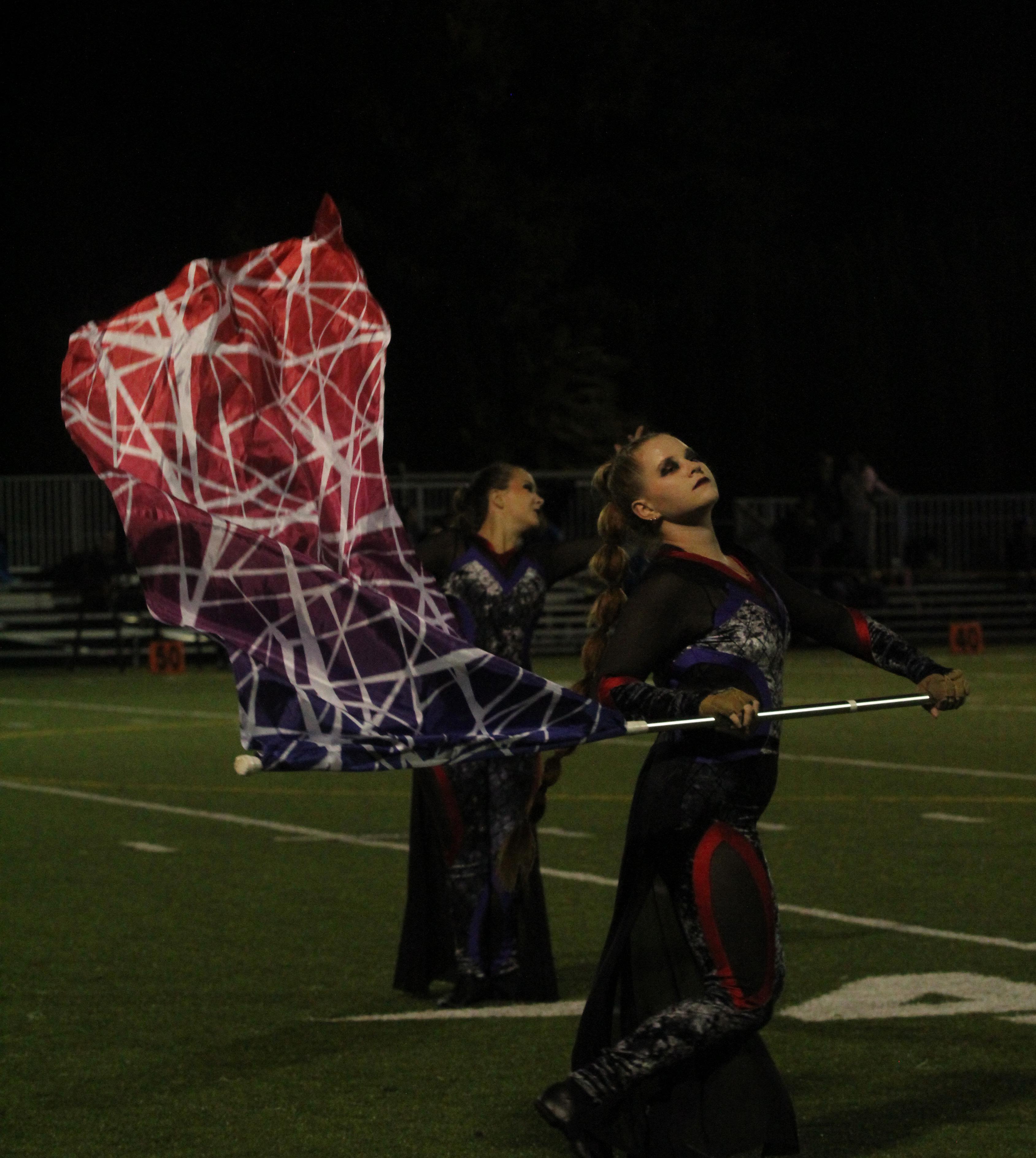

Welcome Freshmen!: Sheldon 101
Maxwell Berry page editor
Sheldon 101 Class is a big deal for Sheldon. This new class is designed to help freshmen be successful. It's important that classes like Sheldon 101 stay around and don’t fade out. According to Mr. Rodgers, who teaches Sheldon 101, “You’re giving all the kids extra time to get their work done, especially the ones who need it.” This is an interesting perspective, especially from a STEM teacher’s perspective where courses particularly tend to build on themselves, a lot more than say literature or history. To Rodgers, this goes beyond academics. Rodgers said the class lets students get to know their teacher better which seems to create a better Sheldon community as well as better communication which then ties back to academics, leading students to higher grades and better test scores.
Senior Julia Johnson said IHS prepared her for later years academically, but she could have used this class as a resource socially. According to Johnson, a good introduction to high school class is something like this: “I would probably have it be like a fun class, like you learn where things are in the school, but then you also probably just play games and like get to know the other freshmen in your class, so it's more focusing on the social aspect.” Johnson clearly favors the social aspect of this class which makes sense from someone in IHS who has lots of preparatory classes for junior and senior year.
Freshman Conner Clark is in Sheldon 101 and said, “I feel like I already know a lot of study habits, but maybe like for other kids… I haven't learned a whole lot of new stuff so I've already got pretty good study habits because my dad teaches me stuff. So it's a lot of review.” Clark also said, “We got some presentation on taking notes,” so there are some positive aspects to the class.

The Cell Phone Policy and How It’s Affecting Students
Claire Green staff writer
Social studies teacher Catliyn Thomspon expressed her view on the new phone policy and soon to-be phone ban in January. Thompson revealed what teaching with phones in school is like, and how it can make it difficult for her to do her job: “It’s hard to teach when you feel like only half the people are paying attention.” With phones being banned, Thompson is hoping students will be more attentive in class and make it easier for everyone to learn.
Thompson feels it’s worth it to ban phones, but is nervous about how things will play out in a few months when they are fully banned. “I’m a little worried about what’s gonna happen in January. When they’re supposed to not have them at lunch.I don’t know how that’s going to work. I’m curious.” Taking effect on January 1 2026, Oregon governor Tina Kotek has banned all phones and headphones from schools throughout the entire school day.
On the new policy, counselor Cassie Day voiced her opinions. Day expressed how the phone ban affects her as a counselor: “We do have a lot of parents that are starting to become concerned about their students
and their 504 plans.” Day, also expressed as a parent herself, is worried about the phone ban. Day is on the fence with this new policy, in that students can benefit or not with the banning of Airpods. “I can see how there are a lot of students that really benefit from having, like, music playing when they’re working in somewhat of a background distraction… but I also know that there are a lot of students that are doing things that are not to help them, right?” Day is hopeful that with this new policy students will have reduced anxiety and have better focus in class.
English 9 teacher, Shiloh Jackson shared her opinions and experiences with the new phone policy. Jackson shared how banning phones is leading to issues with computers. “I mostly teach freshmen and now it’s a battle of the laptops… but I rarely see phones in class, which has been great compared to last year.” With students leaning to laptops instead of phones, it has caused a problem in the classroom with using them incorrectly. Jackson also shared her thoughts on Oregon’s 47th out of 50th ranking for public school system, and if she thinks banning phones will result in a higher future ranking. “No” I think there’s other reasons for that. For our ranking. It might help a tiny bit. But I think there are many other issues.” Jackson said phones are not the reason for this ranking and there are other causes for this.

by
Graphic
Maxwell Berry
Sheldon Students using tech near one of the planters.
photo by Maxwell Berry
Claire Craig page editor
In the digital age, the lens through which students view themselves changes often. Your smartphone camera, the sports photographer’s professional setup, a developed baby photo in black and white, all snapshots of how you appeared at a moment in time. Cameras, amazing tools that capture light through simple glass lenses, create photos that are only a frame of life’s true experience. Social media propels the rate at which we share photos, conflating our day-to-day perceptions of others. Simply checking someone’s page will not reveal their whole life to you. Photos are edited, imperfections excluded, it’s only what they choose to let you see. “I think it’s a little deceptive, but can also be interesting to view someone’s perception of themselves and how they want to portray themselves, it can give you, sometimes ironically enough, a more full view of that person.” senior Dylan Ward said. When this tool becomes shoved in our faces constantly, it begs the question, do cameras still propel and affect human connection as they once did?
Students worry about yearbook photographers ‘clipping’ them at an unusual angle, immortalized forever in the school’s record. Sharing photos that contain a depiction of someone else violates their privacy as well as peace of mind. According to senior Lucien French, “IF you share it with someone, hey I’m sharing this… [I’m] stealing someone’s memory.” When taught ‘proper usage’ of social
Sing Your Heart Out, Dublinaires Cameras and Comfortability

media in advisory or by parents there will be a bullet point: ‘Ask before posting a photo of someone.’ Even with friends, this rule of thumb should apply.
Screenshots operate similarly to an off-guard ‘bad photo,’ they instill a fear of preferably uncemented moments in time shown to a larger audience. Private text conversations can become aired to the public, or in some cases personal photos leaked. We don’t expect personal slices of our life to be used as fodder against us, but students are increasingly worried about how they’ll appear to others. Screenshots are a common way to present evidence for or against a personal argument. Editing such a thing reduces your persuasiveness; sharing unedited screenshots even creates distrust. “There’s also a principle of what’s [in] the photo; it morally belongs to them,” said French.
While cameras are captivating, they can become malicious quickly. Senior Dylan Ingman agreed that photos are “-very useful; they can help convey many different art forms… or expose your ex girlfriend… they can be used maliciously [by] the creepers in stores… or produce pictures of nature.”
Ultimately, photos are our reflection of everyday life; another means to communicate your standpoint. The power lies in the beholder! Do well with it and capture the good moments to the best of your ability.

Callie Clark staff writer
At Sheldon High School, the Dublinaires are a small a-cappella group that sings jazz and modern music. The group is an audition-only choir that meets every school day at 7:30 a.m. Senior Flora Stubbert has been in Dubs since 10th grade and says it’s her favorite part of high school. “We’re together every day, early in the morning,” said Stubbert; “The group is really close.” Dubs sings harder music than other choirs, and members need to be able to match pitch and be skilled in music theory. The group also has fun traditions, such as clapping for one another when they enter class on Fridays and visiting the pumpkin patch in the fall. This year, Dubs will compete in a high school version of a Pitch Perfect-style competition. Still, Stubbert said she likes concerts more because they’re less stressful and more fun. “I’ve become a better musician, and I’ve made some of my best friends,” said Stubbert.
Senior Sarah Aasheim has been in Dubs for three years and calls it the best part of high school. “Waking up early is tough, but it’s always worth it,” said Aasheim. For Aasheim, it’s about starting the day with people she cares about and doing something she loves. Something Aasheim enjoys is the attendance questions. The choir always begins class with an ice breaker or “would you rather” kind of question that helps the group learn more about each other.
Aasheim also enjoys the learning experience of competitions, even though they can be nerve-wracking. “I like seeing other choirs and hearing new music. It’s a great learning experience,” said Aasheim. One quote that sticks with Aasheim to help with the nervousness of competitions is from Megan Perdue, the choir director, who said, “You’re not nervous, you’re excited.”
What Aasheim loves most is the sense of community. “I’ve met some of my best friends here. It’s a place where you grow together, both as musicians and people,” said Aasheim. Being in Dubs has helped Aasheim discover
what she wants for her future. She plans to continue choir in college. For her, choir isn’t just a class, it’s an experience that has shaped who she is today.
Maddox Walker, a junior who’s been in Dubs for three years, said the best part of the group is the people. “They’re some of the nicest people I know and are fun to hang out with,” said Walker. Learning to read music was challenging at first, as he didn’t have any prior experience, but being in Dubs and Varsity Choir made starting high school a lot easier. “You see these people every day,” said Walker. Even though performing can be a little nervewracking, once Walker’s on stage, he enjoys performing. In conclusion, Dubs is about more than just singing. For Walker, Aasheim, and Stubbert, it’s a group where they’ve made close friends and great memories. Between early mornings, fun traditions, and performances, Dubs has become a special part of their high school experience, something they’ll carry with them long after they leave Sheldon.
graphic by Claire Craig
Eye’m watching you.
Balancing Sports and School
Isabella Curtis staff writer
Balancing school and sports can be difficult. Just ask sophomore football player Brody Tubbs. “It’s hard to stay on top of work during the season,” said Tubbs. For student athletes, each day is a challenge to stay on top of work. Between school, practices, and homework, there’s little time for anything else, and the stress builds quickly. Tubbs said, “It feels like there’s never enough time in the day.” Tubbs doesn’t rely on planners to stay organized. “I just do homework whenever I have the chance. My free time is for homework.”
Tubbs feels that not all teachers fully understand what student athletes go through every day just to get work done: “Sometimes, I don’t think they actually understand how much of a commitment it really is, and most teachers aren’t that helpful when it comes to work outside class.”
Balancing school and sports is something many student athletes at our school take on. Sophomore, cheerleader Findley Smith shared the challenge of managing school and sports. Smith admits that managing schoolwork during the season is far from easy. “Yes, it’s hard when practice is in the afternoon; it doesn’t leave much time in the evening to do work after school.” This lack of time creates a cycle of stress that’s difficult to break, especially when work keeps piling up.
“I don’t feel like school is designed for athletes to take harder classes like AP,” said Smith despite the pressure, Smith has found ways to stay afloat with increasing workload. She says the key is knowing how to prioritize. “Breaking it up into small bits really works for me.” Smith believes teachers can play a key role in supporting student athletes but it starts with understanding. Above all, she hopes for more awareness of the unique challenges student

athletes face. “Most teachers don’t understand how hard it is to be a student athlete, and all the stress and work it comes with,” Smith said.
For student athletes like sophomore soccer player Kate Peterson, balancing school and sports is a daily competition against the clock. “It’s definitely hard to stay on top of work during the season,” said Peterson; “we have practice, games, and workouts throughout the week, so it takes up all the time outside of school.”
“I get stressed about schoolwork because there’s always so much,” said Peterson. Her strategy to manage it? Homework nonstop. “I do homework before practice, after practice, and once I get home. All my free time is for homework.”A typical day for her is packed from start to finish: “Wake up, go to church class, go to either morning practice or zero period, go to school, do homework, practice, weight training, homework, and then finally go to bed.”
So how does she stay energized with such a packed schedule? “Sometimes I sleep during school in class when I’ve finished all my work,” Peterson admitted. It’s not ideal, but it shows the lack of time many student athletes face. “Yes, I feel like I never have enough time in the day. The work never ends.” One of the toughest parts is that teachers don’t always understand. According to Peterson, “They don’t realize how much time it actually takes up; it’s not just a practice, it’s a whole lot more.” Peterson finds it hard to talk to teachers when she falls behind. “They usually blame it on us for choosing to play a sport,” explained Peterson. Despite the challenges, Peterson has developed strategies to manage her workload. She uses timers to stay focused and make the most of short windows of free time. “I do work whenever I have free time in school. If we finish early, I’ll do homework,” Peterson said. She’s also learned to prioritize and make sacrifices.
Running or Nothing
Peterson staff writer
Sports is an activity at Sheldon that allows students to go beyond their limits and reach places not many wish to travel and everyone strives for. Cross country is a prime example. At Sheldon, cross country is for everyone to experience, participate and love! But why should people get involved? Why is cross country important for students to participate in? What’s so great about it? One of the coaches, coach Ian Dobson said, “The importance of cross country is that it’s a no-cut-sport meaning that if anyone wants to be in it and work hard, then you can be successful.” Cross country brings a lot of opportunities for athletics including significant physical and mental health benefits, a chance to be part of a team, and personal growth.
Coach Ian said, “it’s not about how fast you are, [or] if you can make the team or not. Again, it’s more about how much work you put in and how willing you are to be a part of the team.” This mindset teaches cross country students more than just how to compete, it teaches them how to persevere. But what if you aren’t doing enough, what if you aren’t going hard enough, what if most of your team is ahead of you, who is gonna help you?
Sheldon Variety-Runner Lucas White said, “I tell them to work hard. No matter how fast they’re going, finishing is the most important thing.” That simple message captures
“I have no social life,” she admitted. But for Peterson, focusing on school and sports comes first.
Peterson believes there needs to be more support and understanding from teachers and the school system as a whole. Fewer homework assignments wouldn’t hurt either. At the end of the day, student athletes are learning how to juggle responsibilities and push through, even when things get overwhelming. It’s not just about winning on the field, it’s about finding a way to succeed in every area, even when the clock feels like it’s always against you.
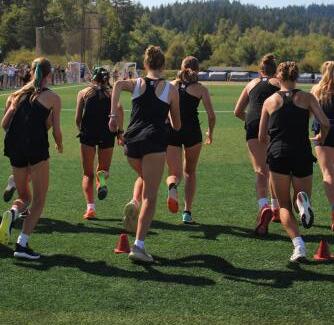
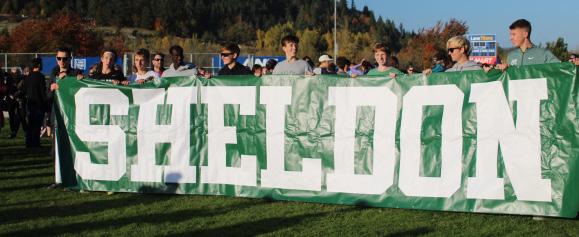
the spirit of the team: it’s not about being first, it’s about finishing strong. In cross country, you aren’t alone. You have teammates, friends! This isn’t a personal drive, it’s a team effort. Every mile ran, every hill climbed, goal reached, all helps athletes build patience, mental toughness, and self-confidence.
Junior Cole Cowin said, “The team, having such a tightknit and friendly group of people running alongside you, makes the sport so much more enjoyable.” That sense of teamwork is what makes Sheldon’s cross country program stand out! Sheldon cross country has a lot of fun aspects, goals and passions. Cowin said, “Beating your ‘personal best’ in cross country is one of the most exhilarating feelings; putting weeks of work into running faster than you have ever before is a feeling that never gets old.” Runners cheering at each other at every meet, celebrating personal bests, pushing through tough workouts together. Whether it’s sharing advice, running side by side, or finishing strong as a group, every athlete contributes to a culture of encouragement and determination. At Sheldon, cross country isn’t just a sport, it’s a family that runs together, grows together, and finishes together. It’s about working hard and proving to yourself that you can make the distance.
Josiah
Varsity girls team kicking off their 5k at the starting line.
photos by Claire Craig
Varsity boys rep Sheldon celebrating the end of the district cross country meet.
Finley Schoenherr (Fr.) sprinting to the finish line.
High School Across Borders
Fateen Anzum Anto page editor
An exchange program allows students to study in another country, explore new cultures, and gain global perspectives. I became an exchange student because I wanted to learn beyond textbooks and experience life in a different education system. Being an exchange student feels inspiring and eye-opening. It teaches independence and respect for cultural differences. In Bangladesh, high schools are structured around fixed curriculums with science, arts, or commerce streams. Classes are more lecture-based, and exams play a major role. In contrast, U.S. high schools offer various courses, encourage participation, and focus on creativity, projects, and critical thinking. While both systems aim to educate responsible citizens, their methods differ. Bangladeshi schools stress discipline and academic rigor; American schools emphasize freedom and practical learning. Students in both countries value education but experience it differently. Reflecting on my U.S. school experience, I’ve learned that education is more than grades—it’s about growth, curiosity, and understanding the world. Another lesson is— not better, not worse, just different. This journey has truly changed how I see learning and life.
I also learned about what education is like in Spain from fellow exchange students. Their schools begin with Primaria (grades 1–6), then ESO (7–10), and Bachillerato (11–12). Spanish schools have strong traditionsChristmas performances, year-end trips, and no personal devices. Students have limited subject choices, and exams come every trimester. Compared to that, U.S. schools feel more flexible and easier, but promote individuality and creativity.
From my Japanese friends, I learned that schools in Japan are very organized and disciplined. Students clean their classrooms every day, wear uniforms, and take part in after-school clubs. The classes are quiet and focused, and students are expected to listen carefully rather than speak out often. Exams are tough, and there’s a lot of pressure to get into good high schools and universities. Still, the system teaches students to work hard, respect others, and take responsibility. Compared to U.S. schools, which are more relaxed and creative, Japanese schools are stricter, but very community-oriented.
After seeing how schools work in Bangladesh, the U.S., Spain, and Japan, I’ve realized that each system has its own way of helping students grow. Some focus more on discipline, while others on creativity or teamwork—but all try to prepare students for real life. What matters most isn’t the system itself, but what we take from it.
Multilingual Voices in Oregon
Jessica Fitch editor-in-chief
Despite being one of the less ethnically diverse states, Oregon does have students from other countries, cultures, and ethnicities who are often overlooked due to their being less common than in other parts of the country. Senior Angel Randhawa is one such student. Her parents immigrated to America from India before she was born, but she didn’t start learning English until she went to school. “I first started learning English when my sister came home from school, so I slowly started picking it up before I started kindergarten,” Randhawa said. The majority of students who learned English as a

second language in Oregon speak Spanish, but this is not the case for Randhawa. “I think taking English Language Development caused social struggles for me. Everyone else spoke Spanish while I spoke Punjabi, so I was kind of isolated,” she said. These systems being designed specifically for one language, while efficient, leads to the exclusion of students who speak other less common languages.
When the established language learning systems fail, some students decide to take matters into their own hands. Take orchestra director and music theory teacher Pete Amawattana, for example. He said, “My first language is Thai…I didn’t have a proper grasp on English until sixth or seventh grade, and the years before that were really cumbersome and I struggled a lot…The most helpful thing while I was learning English was reading a lot. I’m a more independent type of learner, so getting to do it myself was really valuable.”
Learning a second language is a process, largely due to significant differences in syntax and grammar between one’s native and second languages, among other things. Amawattana said, “Because Thai is a tonal language, sarcasm isn’t expressed through vocal inflection. Sarcasm in Thai is all about hyperbole: you exaggerate something to the point that it’s nonsensical. This difference was very difficult for me to understand.” Differences like this, however, are part of what makes learning a second language so beneficial: expanding one’s understanding of the ways in which language can function has documented positive impacts on neuroplasticity.
Japanese teacher Yoshiko Shioya knows a thing or two about the differences between English and her native language, Japanese. She said, “I took an ESL class for adults with other international students. My experience was great: great classmates, great teachers. However, I was
“It’s about growth, curiosity, and understanding the world.” -Fateen Anzum Anto

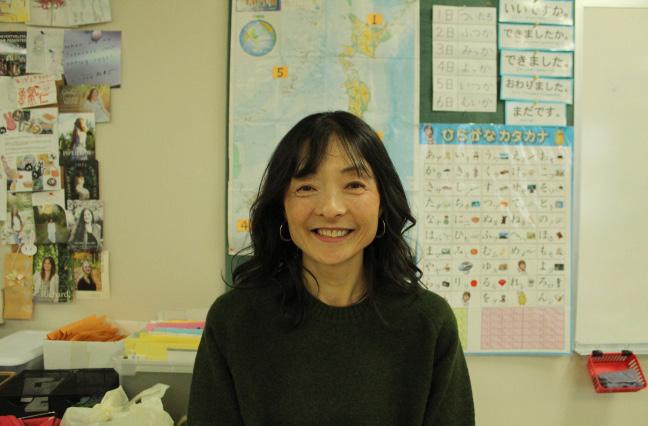
the only Asian student among the international students. They were all from Europe and Latin America, so they all read really fast, because the alphabet is the same and there are lots of cognates. I felt handicapped.” This experience of hers ties back to that of Randhawa, who also felt disadvantaged in a system designed for speakers of Indo-European languages.
That doesn’t mean that Japanese is easy for Shioya, though. “I’ve been away from Japan, so my Japanese is worse than most adults’ in Japan. I haven’t been living there, and my whole professional life has been [in the U.S.]. But it is still my mother tongue.” This tension between Japanese being her native language and her adult life taking place primarily in America means that she is rather disadvantaged back home, as well. Regardless, becoming bilingual has provided her with many opportunities and life experiences she would not have otherwise been afforded.
Japanese teacher Yoshiko Shioya poses for the camera.
photo by Jessica Fitch
graphics by Fateen Anzum Anto Letters from different languages.
graphic by Fateen Anzum Anto Different school, different vibes.
Saved by the Bell - After-School Activities
Ezra Fajardo staff writer
Once school and sports are over, for the year most students finally get some time to themselves. Everyone spends it differently: some relax, some hang out with friends, and others stay busy doing the things they love.
Freshman Owen Boudavong, said his free time is all about relaxing, “If I had a free day with no school or sports, I’d probably just watch football and chill at home.” Boudavong also likes going to concerts and sometimes makes friendly football bets for fun. In the summer, he spends most of his time sleeping in, playing video games with his brothers, and hanging out with friends. His favorite hobby is fishing, and he likes going on walks because he enjoys the fresh air. One thing he’s really proud of is recovering from meniscus surgery, and he said he wishes he could relive going to a Carti concert.
Sophomore Gideon St.Clair, likes to keep a balance
between working out and spending time with people he cares about. “If I had a day off, I’d probably go to the gym and hang out with friends or my girlfriend,” St.Clair said. He likes basketball, lifting weights, bowling, golfing, and just being outdoors. During the summer, he travels with his family and works out a lot. He’s proud that he’s learned how to cook healthy meals and even picked up some skills with mechanics and electronics. One of his favorite memories was a basketball trip to Kansas not just for the games, but for all the fun he had with his teammates.
Sophomore Owen Ashton also likes to stay active but makes sure to relax too. “On a free day, I’d probably start by working out, then shower, make some food, and play video games,” Ashton said. He loves Weightlifting and sleeping both make him feel good. In the summer, he usually works out in the morning, cooks, works at the pool, and ends the day playing games with friends. For outdoor fun, he likes climbing and swimming in lakes. One of his goals is to bench press 315 pounds and he’s only 15! While those three like to mix fun and fitness, Chase Collins and Howie
Fausett spend most of their time outside exploring.
Sophomore Chase Collins loves the outdoors more than anything. He’s always fishing, hiking, or camping with his friends. “I can’t wait to get my license so I can go fishing more,” Collins said. He likes being near the water because it’s calm, but also exciting when he catches something. He also loves camping, especially sitting around a fire with friends after a long hike. Collings is a great cook too and enjoys trying new recipes. “I eat five meals a day,” Collins said, laughing. He’s been lifting weights since he was six and still works out all the time.
Sophomore Howie Fausett has his own way of spending free time.“I like to sleep, eat, and work out,” Fausett said. Like Collings, he stays active and hangs out with friends. When he’s not in the gym, he loves going to the coast. His family has a house there, and it’s one of his favorite places to be. Whether he’s fishing, swimming, or just relaxing by the beach, Fausett always finds a way to have fun.
Even though all five students do different things, they all have one thing in common - they make their free time count. Whether they’re fishing, lifting, gaming, or just chilling, they all find ways to stay happy, have fun, and enjoy life outside of school and sports.
graphics by Khaya Ainis-Michael
Why Do We Clash?
Ronan Sterling & Michael Renzi staff writers
“Clash Royale” has been one of the most popular mobile games for months now and anywhere you go in Sheldon you can find someone with it downloaded. Since its rise in popularity it has gained many comments from its players, everything from the hate of the game to the absolute love for it. The game has many things for players to do, like making your own deck of cards, and grinding the trophy road. One of these players is sophomore Colin Phillips, who’s played Clash since the end of last school year. He started playing because of friends. “I’m currently stuck in Hog Mountain; I hate it,” said Phillips. He said he has a love-hate relationship with the game. His card deck contains three spirits, skeletons, a spell, goblin gang, bomber and of course berserker, one of the most famous cards right now.
“Clash Royale” has a lot of people hooked on the game by keeping up with updates, but how does Supercell, the creators of the free game, have the resources to keep up with the community? Simple answer, micro-transactions. The game has multiple things you can buy to progress further in the game way faster than someone who doesn’t spend money. People spend money on the game all the time, buying new cards like mega knight or boss bandit in early arenas or even leveling up your cards to max level in arena four like sophomore Conner Banyard! “I’ve





probably spent around $200 on the game just leveling up my cards alone,” Banyard said. He’s spent enough money to max out his royal giant level, with having a bunch of other cards overleveled. But even overleveled cards don’t mean skill. Banyard mentioned “Sometimes I’ll win and I love the game, but then sometimes I will go on a losing streak and I want to smash my phone.”
Every game has a part of it that’s harder than the rest. In trophy ranges under 6k it is fairly easy, but upon entering the 7k to 9k range, players seem to struggle the most. Where people face max level cards all the time.
Collage of Clash Royale characters
One of the players stuck in this phase is sophomore Grayson Fife. “I swear this game is actual ragebait. Last match I three crowned a guy and then next match I went against somebody with level 14 boss bandit and a bunch of other maxed cards,” Fife said. This is easily the hardest part of the trophy road. But it’s all worth it in the end, when you hit 10k trophies.



Top: Student jewlery.
Bottom: Adidas Sambas, a common choice of footwear among high schoolers.
Cutouts (L to R): Khaya AinisMichael, Claire Craig

Next in Fashion
Isadora Alvarado staff writer
What happens when high schoolers step into the world of trendy fashion? For some, it’s a fun way to express themselves through what they wear. Styles like comfy, coquette, and streetwear are all over social media, and opinions are mixed. Some people love the look, while others aren’t fans. “I prefer wearing comfy clothes to school and just in general,” said sophomore Scout Burrell. Many teens feel the same way, using comfortable fashion as a way to show their personal style. For Burrell, dressing comfortably is how she expresses herself. Burrell also has certain color combinations she dislikes. “Dark brown and hot pink just don’t work well together,” said Burrell. While those are both very popular colors right now, Burrell thinks they clash together. Burrell’s opinions show that fashion is more than just trends, it’s about feeling good in what you wear and choosing what fits your own style.
Another major part of fashion this year is shoes. Junior Kamai Davis noticed the trending shoes recently, “Uggs and Birkenstock clogs are probably the most popular shoes
right now. I like them both because they are really comfy for all the walking I’m doing in school,” said Davis. Students like to be comfortable if that means being in class or walking around campus.
Uggs and Birkenstocks have always had a place in fashion, but in recent years, they’ve made a major comeback, largely by social media and the influence of online trends. “I think social media has definitely influenced fashion, because I see a lot of people wearing the same things,” said Davis. She said that comfort and social media influence play a big role in what students choose to wear.
Have you ever followed a fashion trend, only to later regret ever stepping out of the house looking like that? Over the years, fashion has gone through all kinds of phases from parachute pants to low rise jeans to the cozy era of sweatpants and sweatshirts. Sophomore Ari StrutinQuintero has experienced that feeling as well. “My style has changed a lot and the clothes I used to find cute, I don’t really anymore,’’ said Strutin-Quintero. Many students wear clothes that show their style, but as they grow, so does their style, and that’s the fun of it. Fashion is constantly evolving, especially among teenagers who are figuring out who they are and how they want to be seen. And while some trends may not age well, they often reflect a moment in time and a moment of self-discovery.
Fire Fits
Is fashion just about clothes, or is it something more personal? How do students at our school use fashion to stand out or fit in? What’s really trending in the hallways, and who decides what’s “cool?” While baggy pants have become increasingly popular among teens, opinions vary. “I really like them, as you can tell because I’m wearing them,” said sophomore Elise Hudkins; “I find skinny pants really ugly and uncomfortable, while baggy pants are very comfortable.”
For many teenagers, including Hudkins, accessories are a must-have part for putting together an outfit.
“I find it plain and boring without accessories in outfits,” said Hudkins. “My must-have accessories are earrings and I sometimes wear necklaces.”
However, Hudkins said that she rarely wears necklaces with hoodies. “I don’t think a necklace with a hoodie looks good,” Hudkins explained, “I usually only wear them when I’m not wearing a hoodie.”


What’s the first thing people notice about you when you walk into school? For many students, it’s your outfit. Fashion has become more than just clothes, it’s also a way for teens to express themselves, feel confident, and even stand out. Sophomore Addison Spriestersbach shared her thoughts on current fashion trends. Many students follow a popular fashioned trend known as the “sandwich method” which involves balancing colors or pieces by repeating them on the top and bottom of an outfit.

“I think it’s cute and makes outfits look balanced in some way,” said Spriesterbach; “Some outfits without the sandwich method look tacky.” Many students, including Spriestersbach, expressed her dislike of neon colors in outfits. Spriesterbach explained, “If people wear everything neon like shirts and pants, then yes I find it ugly.”
How would people describe the style at school? What influences the way people dress? Is it friends, trends, social media, or their own taste? One big fashion trend is jerseys being used in outfits. Many people love this trend and some people don’t. Sophomore Taylor Guerin thinks it depends on how it’s styled. “If you can style it correctly then yes, it’s cute,” said Guerin. At Sheldon High School it’s rare to see people wearing bucket hats. Guerin believes that bucket hats are no longer in trend. “I think bucket hats are no longer in trend and was left in 2020,” Guerin explained; “They used to be cute, but some people can [still] pull them off.”
photos by Claire Craig & Khaya Ainis-Michael
Kennedy Zuniga staff writer
The Resourceful Irish
Sarah Palmer & Carmen Uria Carrillo staff writers
High school can be hard, but Sheldon offers many ways to make it easier for students. As a school, Sheldon offers a range of services, including food, clothing, shoes, mental health support, school supplies, laundry facilities, showers, personal care products, shelter or housing, transportation, college application support, job application assistance, and drug and alcohol counseling. In obtaining and creating these resources, Sheldon works with 15th Night, but what is that? Trista Newman, 4j’s 15th Night coordinator, explained, “15th Night Program Coordinator is basically [when] I go into each of the high schools and I have a team that conducts assessments.”
According to Newman, RAN (Rapid Access Network) is one of the most effective programs for connecting kids with the resources they need. “It is a technology that we use, and all staff members at Sheldon are trained on it. So any staff member at any time can send an alert,” said Newman.
Many of these resources are overseen by Sheldon staff, one of whom is Business and management teacher Les Philippo. “Most schools have something like a clothing closet, where you need someone to let you in to look around, and it often carries a bit of a stigma,” Philipo said. “We wanted to make ours different. This is a school project, and it would be great if all students took pride in it and helped keep it clean and well-maintained.” Philipo not only organizes Irish Outfitters, but he and his wife run Makki’s Catch, a scholarship opportunity that gives scholarships to kids who need mental health support.
“I think it’s a good resource to have for people who can’t afford clothes,” sophomore Emy Broderick said; “The most important resource is probably the menstrual drive. There are a lot of people out there that can’t afford that stuff.” Resources are important for all people. These are
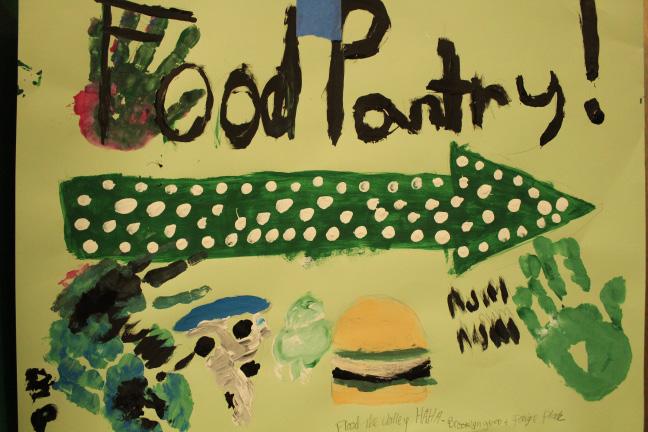
ways to help people in your community, so take what you need, and give what you can.
So how can you help? The biggest issue according to Newman is, “How do we remove the barriers [and stigma]? I don’t know how to do that as a 53-year-old, but you guys know how to do that. And so we rely on students.” 15th Night is run by youth just like those who go to Sheldon. Newman said, “The Youth Action Council is made up of students who have high school experiences. Either they dropped out of school, they navigated school but struggled because they were homeless, or kids who have never been homeless, but have a passion for serving the community and stuff. And so our Youth Action Council dictates everything we do.”
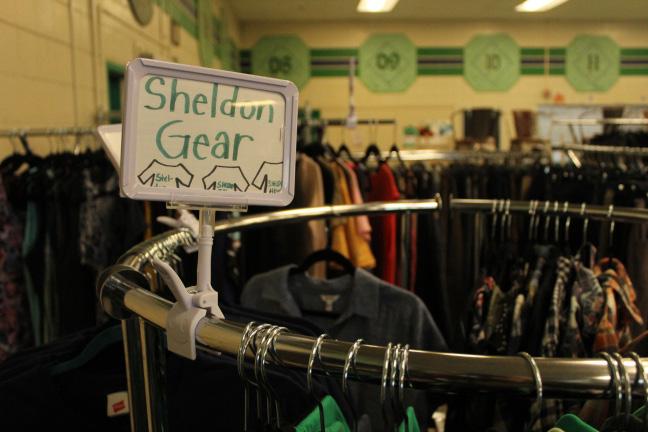
IHS Student Government
Addy Zauner staff writer
You’ve probably heard of a student body government before — but did you know that the International High School (IHS) has its own? The IHS government mirrors a government structure, but it’s made up entirely of IHS and IB students. Members meet every Thursday at lunch in room B17 to discuss and brainstorm new ideas and plan events. They plan out assemblies and the 50/50 raffles that they do for their fundraising.
The current president is senior Rosemary Ruiz. She has been the president for the past two years and she was the Social Media Manager her sophomore year. “[My] favorite events to plan are the tri-campus events,” said Ruiz. The schools that are a part of the tri-campus are South Eugene, Sheldon, and Churchill. They all work together to plan out the IHS assemblies that happen. There are two that happen over the course of the school year. The first one is in the fall and the second one is at the end of the school year where people who are going to graduate with a IB diploma are recognised.
Members are free to join any time as long as they are a part of IHS at Sheldon. One of the newest members, junior
Abby Kubu, joined with a clear purpose. “I wanted to make a memorable impact on my community and represent a voice for my peers,” said Kubu. She hopes to work her way up to becoming the Junior Secretary.
The government also plans the IHS field day that happens at the end of every year. “I think that they are nice people,” said; junior Aaron Hartsfield. He and many other IHS students enjoy going. Through leadership, collaboration, and community involvement, the IHS Student Government continues to shape the high school experience for its members and classmates.














Top: A sign reading “Food Pantry!” made by freshmen during summer bridge. Bottom: The Irish Outfitters.
photos by Jessica Fitch
graphic by Jessica Fitch
Teacher Feature: Featuring The Teachers
Wudi Auld page editor
1994 was the year Mrs. Tierney graduated from Lake Havasu High School in Arizona. Tierney has always had a passion for literature and teaching, and was appreciative of all the teachers from her high school years who supported her growth. Her first being her English teacher Mrs. Hollis, Hollis admired her passion for literature according to Tierney, “She thought I was a good writer and that meant a lot to me.” Her second inspiration was her art teacher Mrs. Mick, with whom she served her detention time and felt she could be her true self around. She keeps contact with both Mrs. Mick and Mrs. Hollis to this day.
Tierney kept a close knit of friends. Her best friend of 35 years, Nicki, whom she met in student government during junior high. Niki and she shared a wide range of classes together even with their age difference. Niki went on to teaching as well and lives in Florida now.
Tierney didn’t value homework growing up, but believes now it is crucial for fully understanding subjects. While talking too much in the classroom could be annoying, Tierney is concerned her students have lost their ability to communicate, “There’s less face to face community, less of group identity.” She believes her era thrived with community due to the lack of electronics like cell phones. Tierney prefers the older ways, standing by the fact electronics are holding us back socially.
Clair Smith, one of our beloved school counselors, graduated from the mighty Acorn in Oakland, Oregon, in 1994. Ms. Smith was a super well rounded student from participating in track and field, volleyball, and basketball.
Her parents never cared much for her grades but her teachers kept her pushing to maintain good grades, putting the incentive that she could go off to college if the work was put in.
She never saw herself going into teaching since she majored in political sciences with a minor in business. She was told a lot growing up that teaching would suit her and
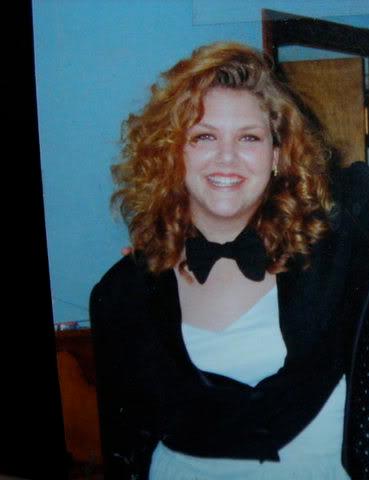
Doomsday vs. Teachers
Andrew Brown staff writer
A ‘doomsday event’ or utter catastrophe, for most humans means the last day of your life, but have you ever wondered, what would my teacher be doing during this time? Would they be assigning homework? How would their teaching style reflect on their ability to survive a zombie attack? Or even worse, a robot attack? Would their hatred for Chat GPT transfer to robots as well?
Senior Ethan Cottle said, “I think the teacher that would survive the longest would for sure be Mr. Brancato. He’s always showing photos of his fish during class, so at least I know he can fish to survive.” The sentiments said by Cottle reflect his overall opinion of Doomsdays and what kind of people would survive in the first place; “I think it’s cliché but I think the manliest man would survive, and I think Brancato is the closest to that idea.”
Andrew Cabrera, a loyal and quality teacher in the
English department, expressed his beliefs of what he thinks would be the must beneficial, last lesson he would teach before the implosion of society, “ I think that improv would help; it goes along with what people will need to do to survive.” Cabrera also stated what in his classroom would help society after doomsday, “A dictionary. It might be the last one ever, and will help rebuild language.”
Senior Matthew Chunk said, “Me personally, I believe Brancato would survive, because he’s just got a whole bunch of grit.” Chunk continued to go in depth about why he thinks Brancato would be such a good survivor of a doomsday. “I just have known the guy for a long time. He’s my coach, and I think he might be even able to thrive in that environment,” said Chunk.
As the clock ticks and the world spins on, one thing remains clear — doomsday isn’t just about the end, but about how we choose to live before it. Maybe the real countdown isn’t to destruction… but to understanding.
she went back for a masters degree in teaching later. The classroom scene freaked her out and it took her little time to figure out she enjoyed working with kids one on one.
Smith prefers her academics in black and white. Claiming she hated “gray areas” or the multiple choice subjects. Either you would be right or wrong, making math and science her favorite studies. Growing up in a small town and graduating in a class of 32 people, everyone knew everyone and were all friends. She expressed the same opinion as Tierney: the teachers of our school believe we have lost our social skills as a generation. Smith said “The idea that I have to walk people through how not to be awkward is so funny.”
Mr. Summerfield graduated from James Madison High School, Portland, OR in 1980. He was primarily known for his hip hop group Royal Court that consisted of four other people. Summerfield has always been delighted with his social studies classes, being excited to learn about the world around him. He prefers pen and paper for the case studies backing up the process our brains go through while writing, claiming we absorb it better. When he wasn’t at the arcade or movies down the street from James Madison, he would be sharpening his break dancing form.
His passion for teaching grew from interning at an alternate school nearby. He had never planned on teaching but his goal was to “help people help themselves.” While watching people in high school become successful and not successful, he wishes to bring the idea that students’ confidence is what’s going to make or break their ability, not the grades he gives. Summerfield believes the relationship between students and teachers is a “partnership” and as students we lack the respect towards teachers, delaying their ability to teach content when they have to constantly correct behaviors.

Kate Tierney on Prom Night!!
photo courtesy of Kate Tierney
illistration by Emily King
Khaya Ainis-Michael page editor
Where we come from is a huge part of who we are. It influences key aspects of our lives like our names, our treatment in society, and even our appearance. Having mixed ancestry, with how diverse our society is, is inevitable. So why does being mixed feel so lonely? You have more culture, more languages, more opportunities to connect with people, but it feels like everything is lacking. You lack the connection to your heritage and ancestry, and you feel almost wrong for attempting to claim it as yours to begin with.
Growing up in the United States, we are surrounded by all sorts of cultures. There’s a reason we’re known as a “melting pot.” However, in a place like Lane County where 80.2% of the population is white (according to 2022 stats from usafacts.org), that melting pot reputation isn’t as apparent. Spanish Immersion teacher Richard Zapata Bello has been living in the United States for almost thirty-two years, and has been teaching at Sheldon for four. He has
noticed the lack of diversity where we live, and believes that it contributes to a larger idea. “When you’re in the United States, there’s this idea that if you’re Hispanic you’re just Mexican,” said Zapata. But ethnicity is so much more nuanced than that. Every place has their own traditions and customs, and putting such a general label over things with so many differences erases entire aspects of culture.
This lack of diversity and overruling of so many cultural aspects can make it feel hard to call yourself a part of a certain group. If there’s such a set stereotype for how an ethnicity should be, and it’s not how you are, you can feel like you’re not allowed to claim that ethnicity. English and French teacher Shiloh Jackson said, “We all look so different… we don’t control how we come out looking and so many people are so mixed with cultures and ethnicities, and I think that’s what makes everyone unique and what makes our world really cool.”
The United States is built on its different cultures, so many staples of “American culture” come from somewhere else. Our ability to interact with each other is so important to the furthering of our society. We have all been grouped together for so long that there are so many different types
Commentary: Being Mixed Can be Alienating The Use of and Changes to the Library
Andrew Cottle page editor
The Sheldon library is a quiet and calm location for studying or reading. A place populated with all types of people to engage in academic experiences. The library is where the majority of the books in the school are found, an abundance of material and words to consume. Mainly, it is used for studying or a quiet work place. The hushed relaxed environment can bring focus, creating a place where people may study freely without worry. Senior Owen Sinclair stated, “It’s somewhere I can go. The atmosphere here is better. It’s a lot quieter; sometimes there are people talking but I feel like I can focus better here.” The tables give space for many students to work, with many groups of people spread around throughout the library. Some having classes and some with free periods, all quietly working or reading.
Around Sheldon, some students find that reading gives them a chill atmosphere to destress and just relax. Sophomore Tyler Faulconer, talked about how important reading is, said, “I think it’s good for you to pick up a book once and awhile, as opposed to doing other things. It’s just like a really healthy activity, and it’s a cool and just relaxed environment.” According to The National Library of Medicine, reading books is scientifically proven to decrease stress and anxiety, while also improving emotional intelligence. People who read regularly are also less likely to decline cognitively.
With the increase of information in the information age, however, book checkouts have begun to decrease. The new librarian Ms. Griggs (Ms. G) said, “I do think it has a direct correlation to screens, phones, computers. They are coming out with these studies that schools that have banned cell phones in school, their book checkouts are higher.” Ms. G believes that there are many other things
to do than scroll on your phone, such as reading or other healthy activities. With less phone use there would be more reading, and hopefully, after the total phone ban in January, there will be more checkouts.
of people. Terms like “wasian” and “lightskin” have even appeared, because there are so many people that are mixed that there’s a need for a term. English, Sources of Strength, and AVID teacher Kate Tierney has noted a shift in attitudes. “Over the last however many years [students] are a lot more comfortable discussing [their ethnicity], and contribute a lot more critical thinking to the subject,” said Tierney. The creation of terms has allowed for a much more open discussion, and creates less of a question about your ethnicity. If there are other people around you that are the same combination of ethnicities as you, you will feel a lot more comfortable to claim your own.
Being mixed, while being fairly common, can be a very unsure experience. You are never sure whether or not you can say that you are a part of something, or if you can make a certain joke, or agree with a comment, and you are always unsure if you look “colored enough.” It can feel alienating. But it can also open opportunities. You can relate to a wider variety of people and it can be a topic to bond over. Something that is alienating can also be something that creates bonds. Chances are, if you are struggling with something, someone else is too.


by
photo
Andrew Cottle
Sheldon Color Guard and Marching Band Excel
Lizzy Cantwell page editor
Marching bands have become more popular in the U.S due to more schools starting to get involved and DCI (Drum Corps International) becoming more popular. The Sheldon High School color guard and marching band is a rapidly growing community, with over 80 members currently participating in the program. The marching band has competed in the AAA division throughout the recent 2025 season.
Having practices 3-5 times per week, it can be hard balancing academic work with the mandatory practices, Senior Marin Jarvis said, “It’s a lot about knowing what I have to do in both programs, making sure to get the school work done, keeping everything in order, and staying on top of everything.”
Jarvis is also involved in the band’s leadership program where she is the current president of the band. The leadership have worked nonstop this year to provide a welcoming community and environment for members. In band, the leadership team works by talking and knowing what needs to be done to support one another. Jarvis said, “It’s fun to be a part of leadership and it’s nice being able to have a bigger voice in the program. I like being able to express my voice in a program that’s a big part of my life.”
Senior Ellie Bahen said when she joined the marching band, she started connecting with people and forming friendships, “It has really helped me and shaped me through high school, because I have such a big community to fall back onto.”
Bahen is also involved in the band leadership this year, representing the flute section alongside senior Keonhui Baik. Bahen said, “I enjoy being in the leadership, and I think it’s really important to me because when I was first joining, I felt too scared to ask questions, and I was really hard on myself, so I’ve made it my priority to make sure no one else feels that way. It’s really important to me that I can be there to answer questions and help people better themselves.”
Not only is marching very physically demanding, but adding music makes it more challenging. Bahen said, “We
go through hours of being active and working for only a seven minute show.” This year, staff have worked on incorporating more dance moves and choreography in the band, adding another level of physical challenge for band members.
Senior Matthew Clark has the opportunity of being a drum major this season. Drum majors not only conduct the band, they also work non- stop behind the scenes to support members every day. This year Clark is one of the three drum majors, working alongside junior Annabell Marwitz and senior Jack Beach. Clark said, “I tried for the position of drum major this year and received it because I didn’t just want to focus on my own growth for another year, I wanted to focus on uplifting the people around me to further better themselves.” One of Clark’s favorite memories from this season has been the bus rides to and
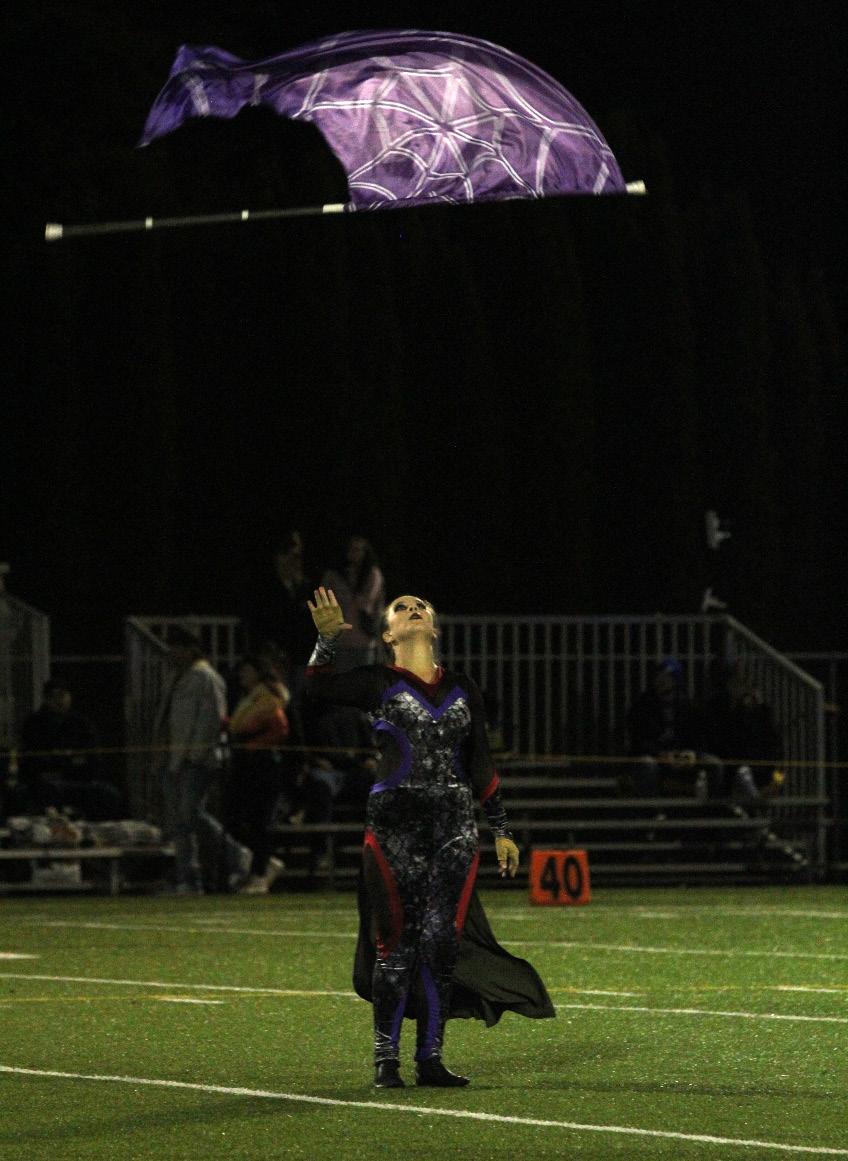
Emma Icenhower (Sr.) preforms at a home football game.
from both competitions, because of the feeling of calm before the storm and then the calm after the performance day. Clark has been a member of the marching band for four years now. According to him, there has been a lot of visible growth throughout the band, not only personal growth amongst his peers but also the growth of incoming members.
At the NWAPA (Northwest Association for Performing Arts) championships on November 1, 2025, the Sheldon color guard and marching band placed fourth in the AAA division. The color guard set a school record with a score of 86, winning the High Color Guard award in the AAA division.
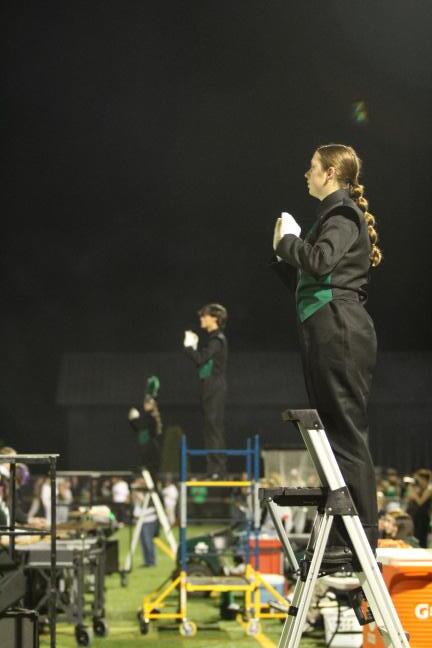
The Best Bloody Baking Show Coming Soon
Chloe Crook staff writer
“The Best Bloody Baking show” is an original piece written by English teacher Andrew Cabrera. After months of hard work, creativity, and collaboration from both students and staff, the audience will see a murder mystery unlike any other. The cast includes over twenty students and several also help behind the scenes as part of the crew. Originally, Mr. Cabrera said that the idea first came from watching a baking competition show last October. “In one episode, a contestant was sick and couldn’t finish, another contestant fell off a stool. That usually doesn’t happen; I thought it would make a good murder mystery.” Cabrera said. During auditions, students were given the chance to create their own characters they think would be a good fit for a competitor. During rehearsals, Mr. Cabrera said he wants to
make sure the rehearsals are productive while respecting the students’ time. “They aren’t always productive. I try to find a balance between making demands and not overdoing it, while still keeping the actors engaged.”
Senior Sarah Aasheim works as the marketing manager and assistant director for “The Best Bloody Baking Show.” She helps organize rehearsals and keeps the cast informed, as well as making sure everyone feels included. Aasheim said that one of the hardest parts of the process was learning to work with so many different people. She tries her best to make every actor feel included and a part of the show. “Building a community has been the hardest but also the most rewarding part,” said Aasheim.
Senior Matthew Gores plays Richie, a humorous odd British man who is one of the hosts of the show. Gores said when approaching this role he tries to put himself in the character’s shoes, then thinks how he would react and potentially change the character depending on what’s happening.
The cast and crew have been putting in long hours to
prepare for opening night. Rehearsals are held every Tuesday and Thursday, where the focus is on arriving on time, staying productive, and bringing the show to life. “The Best Bloody Baking Show” is a baking show adapted into a murder mystery bake off. In total there are nine contestants: Detective Miranda Abode, A British detective who is taking a break off of being a detective; Chase is an Australian influencer; Clover Bloom, a homeschooled girl from Pennsylvania; Aaron Samuel Baker, a billionaire who lives on a private island in Washington State; Shannon Hustle, a mountain mama with 37 grandchildren; Candi Baker, a girl who wants to find the next step in her journey; DJCashMoney$III, a young inspired DJ; Archie Remington an alien conspiracy theorist; and Paul. In the show they will have to compete for the Boss Baker every week. Like in other baking shows, one person wins for the week and one person gets voted off the island. For a total of six weeks up until there is one last competitor who wins the show. But things are not as they seem. Performances will be December 5, 6, 11, and 12.
Drum majors conduct the band during a Friday night football game.
photo by Claire Craig
photo by Claire Craig
Run by students, for students.
Frontpage editor..............................Jessica Fitch
New at Sheldon pg.2 editor...............Maxwell Berry
Lights, Camera, Action pg.3 editor.....Claire Craig
Focus Up pg.4 editor.........................Claire Craig
We the People pg.5 editor...........Fateen Anzum Anto
Staff Writers:
Isadora Alvarado
Andrew Brown
Callie Clark
Chloe Crook
Isabella Curtiss

Aiden
Emily
Ainis-Michael
Fitch
Auld
Never Judge a Book... pg.10 editor........Andrew Cottle
Cantwell
Backpage editor..................................Jessica Fitch Editor-in-chief.....................................Jessica Fitch Staff
Michael
Ronan Sterling
Carmen Uria Carrillo
Addy Zauner
Kennedy Zuniga

Wudi Auld Khaya
Jessica Fitch
Andrew Cottle
Fateen Anzum Anto Maxwell
Lizzy
